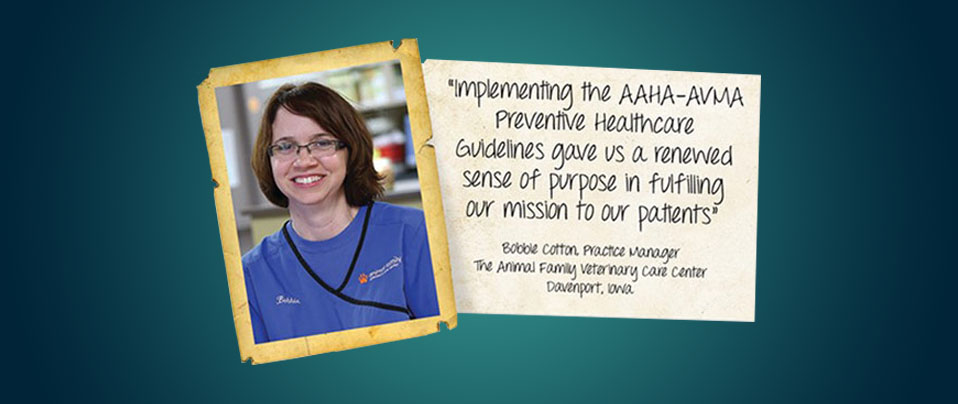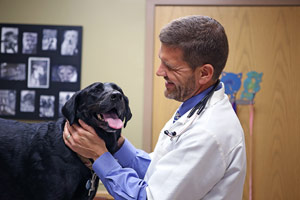Effective Team Meetings

The Key to Implementing Preventive Healthcare Guidelines
How do you organize a 28-member veterinary healthcare team to speak with one voice in implementing the AAHA-AVMA Preventive Healthcare Guidelines? “For our practice, the key was to conduct a series of effective team meetings to introduce the Guidelines and how our practice would use them,” says Bobbie Cotton, Practice Manager at the Animal Family Veterinary Care Center in Davenport, Iowa. “What we didn’t anticipate were the added benefits that came from the team-meeting experience.”
Tips for Conducting Effective Team Meetings
Bobbie Cotton, Practice Manager, and Dr. Scott Bernick of the Animal Family Veterinary Care Center in Davenport, Iowa offer the following tips for conducting team meetings to introduce the AAHA-AVMA Preventive Healthcare Guidelines:
- Assign a meeting facilitator. Generally, this will be the person who is responsible for coordinating overall implementation of the preventive healthcare Guidelines on behalf of the practice. Often a staff veterinarian will assume this role, but not necessarily. At the Animal Family Veterinary Care Center, the Practice Manager and a Patient Care Advisor facilitated the meetings.
- Make attendance mandatory for all staff. This lets the healthcare team know that the practice is making a serious commitment to systematically implementing preventive healthcare and that everyone is part of the process.
- Set aside the time. If possible, hold the meetings during office hours. Leave a telephone answering announcement that the practice is closed during the meetings for in-service training.
- Have an agenda for each meeting. Each meeting should focus on a specific topic (e.g., the practice’s goals for preventive healthcare). Team members should be given an agenda in advance of each meeting.
- Rehearse the meeting. Facilitators should prepare for each meeting. “Free-lancing” the meeting usually leads to a poorly focused event that accomplishes little and dampens enthusiasm among the healthcare team. “We took quite of bit of time to prepare for our meetings,” Bobbie comments. “To do a good job, you have to make that commitment.”
- Assign homework, expect completion. The Partners for Healthy Pets “Team Meeting Guide” provides homework assignments and worksheets that are designed to actively involve all participants in the Guidelines implementation process. These exercises are designed to be fun, not burdensome. Request that everyone bring their worksheets to the next meeting for purposes of discussion.
- Make the meeting interactive. Keeping everyone involved helps ensure a successful meeting. The online tools available from Partners for Healthy Pets are designed to encourage group participation in team meetings. These include role-playing scenarios, “Words that Work” videos to discuss and practice, and homework assignments for group discussion.

Getting started
The Canine and Feline Preventive Healthcare Guidelines are single-page documents, designed to be specific without being overly prescriptive. The challenge for veterinarians is to enable all staff members to routinely apply the Guidelines so they become the practice’s principal focus for providing preventive healthcare. By doing that, clients who are occasional consumers of acute-care services can be converted into regular users of preventive care for the lifetime of their pets.
“Assigning two staff members to champion the rollout of the Guidelines to our healthcare team was the first step in the process,” says Dr. Scott Bernick, owner of AFVCC. “Bobbie and Maggie Rigg, a Patient Care Advisor, were perfectly suited to the task. Both have extensive experience in animal health and welcomed the assignment as co-owners of the rollout. Bobbie is quoted on our website as saying, ‘As much as we do for our pets, they give us so much more. They make us better.’ With that kind of empathy for our patients, I knew that responsibility for the rollout was in good hands.”
Bobbie and Maggie had a valuable resource for introducing the Guidelines to the healthcare team – the ready-to-use suite of professionally produced online tools available from Partners for Healthy Pets. The key to implementing the Guidelines was to use these materials to conduct a series of six well-executed meetings that engaged all 28 members of the practice’s healthcare team. The meetings defined how each team member would apply or promote preventive healthcare.
“The materials were terrific”
Implementing the Guidelines can seem like a daunting task for any veterinary practice. “The beauty of the online tools developed by Partners for Healthy Pets was that they made implementing the Guidelines a step-by-step process,” Dr. Bernick comments. “What seemed overwhelming at first became manageable and, ultimately, enjoyable.”
“I thought the materials were terrific,” Bobbie says. “The inspirational video by Andy Roark was a great way to kick off our first team meeting. The PowerPoint presentation tool was especially helpful because it formed the backbone for each of our six meetings. The PowerPoint template was a great time-saver for us. After customizing the slides for our practice, we had a series of professional-grade presentations that created structure for the team meetings.”
Other online tools that helped Bobbie and Maggie organize good team meetings were the “Practice Action Plan” workbook, a “10 Steps to Success” outline for implementing the Guidelines, and a “Team Meeting Guide” that spells out a suggested agenda for each of six team meetings.
The “Words that Work” videos proved to be one of the most powerful tools that Bobbie and Maggie used for the team meetings. The videos (accessed at the Communications link at partnersforhealthypets.org) covered topics such as relationship building while taking a patient’s history, how to convey value during a physical exam, and dental, heartworm and nutrition discussions. “The videos showed how to explain the reason for these preventive healthcare procedures to clients in a convincing way,” Bobbie explains. “Role-playing some of these client-interaction scenarios let us practice these communication techniques, and helped make the meetings interactive.”
Meetings that works
The team meetings were supposed to last 45 minutes each. “Some of ours went two hours or longer,” Bobbie notes. “That’s because we took the time to discuss all of our preventive healthcare protocols, the reason for each, and how each staff member could support the recommendations, either specifically or generally. In addition, our meetings were very interactive. We invited opinions and feedback from everyone.”
The dialog at the team meetings helped identify blind spots and areas of communication that needed to be improved. “We developed good solutions because the entire staff had input,” Dr. Bernick says. “The meeting agendas went well beyond just walking through the Preventive Healthcare Guidelines. We discussed the practice’s rationale for each preventive healthcare protocol. For example, staff members need to be able to explain why we require a heartworm diagnostic test before the client can buy heartworm medication. We listed three reasons why heartworm testing is important, who was assigned to accomplish each part of the protocol, and gave everyone involved a list of talking points to use when explaining the procedure to the client.”
“We role-played how to explain certain healthcare recommendations to clients,” Bobbie adds. “We knew that not everyone likes to role-play, so we set the stage by telling the group not to worry about performing and to just have fun doing it. It ended up being a confidence-builder, especially for those who were less skilled in interacting with clients.”
Besides focusing on how each team member could support preventive healthcare, “the team meetings had other benefits, some that we didn’t expect,” Bobbie Cotton says. “We had fun, and the meetings brought us closer together. They gave us a renewed sense of purpose in fulfilling our mission to our patients. We felt more confident as individuals in how we can explain preventive healthcare to our clients. The process of discussing why we do things and how we can do them better created a continuous-improvement mindset. And we helped make sure that newer staff were on the same page as the veterans. That’s a pretty good payback for the time and effort invested in our team meetings.”
Why core values are important
One of the AFVCC team meetings was devoted to defining the practice’s core values. “That proved to be an important meeting,” Bobbie says. “When it was over, there was no possibility that our practice would have a ‘make-it-up-as-we-go-along’ culture.”
The AFVCC healthcare team decided that, individually and collectively, they would practice the following core values:
- Positive attitude
- Team player
- Compassionate
- Professional
- Visionary
- Self-motivated
- Effective communicator
- Welcoming
Organizational dynamics experts agree that values are important for several reasons. Values direct behavior and behavior change, guide decisions, explain why things are done the way they are, provide standards of accountability, determine how to interact with each other and with clients, and not least, create a competitive advantage. Whenever the AFVCC staff makes preventive healthcare recommendations to their clients, they are applying some or all of their core values.

The power of ‘why’
The Preventive Healthcare Guidelines explain what to do and how to do it, but they don’t explain why. Dr. Bernick believes strongly that when the AFVCC staff explains the “why” behind any preventive healthcare procedure, pet owners are much more likely to accept the recommendation. “At our practice,” he says,” we want everyone to have the confidence and communication skills – one of our core values – to explain the rationale for our recommendations. It’s a key part of implementing the Preventive Healthcare Guidelines.”
Explaining why sometimes involves sharing personal experiences or case examples that illustrate why the AFVCC staff makes certain preventive healthcare recommendations. Discussing and role-playing these approaches to client dialog were part of the team meetings used to roll out preventive healthcare at AFVCC.
Dr. Bernick recommends Simon Sinek’s book Start with Why as an excellent resource for anyone who wants their behavior to reflect why they are passionate about what they do. “Sinek writes, ‘People don’t buy what you do, they buy why you do it’,” Dr. Bernick recalls. “To a great extent, how successfully we implement preventive health care depends on our ability to explain why, both to our staff and to our clients.
What success looks like
What are the outcomes that can be expected when the entire healthcare team is committed to practicing preventive healthcare? Here are some of the signals that a veterinary practice has been successful in making preventive healthcare its primary focus:
- The staff is confident in making preventive healthcare recommendations.
- Every staff member has a specific role in implementing preventive healthcare.
- The staff operates with a strong sense of teamwork.
- Dialog with clients becomes natural and sincere.
- Conversation with clients becomes an enjoyable and rewarding experience for the staff.
- Explanations of why preventive healthcare is important are specific and detailed.
- The staff conveys competence in the eyes of clients.
- Exam room discussions are broad-ranging and seek to understand the client’s relationship with the pet.
- Client utilization of preventive healthcare services improves.
- Incidence of preventable disease in the practice’s patients is low.
- Compliance improves as a result of client education and a trust relationship between clients and staff.
- Clients value the low incidence of preventable disease, good pet quality of life, and a long-term relationship with the pet and the practice.

Dr. Bernick says that there have been other, tangible rewards since AFVCC implemented the Preventive Healthcare Guidelines. Preventive healthcare visits and services have outperformed the historical averages for the practice. “Over the past year, utilization has increased for regular healthcare exams, heartworm tests, diagnostic panels, and fecal parasite screening,” he says. “Online client reviews average 4.8 stars (out of a possible 5), a source of pride to the entire staff, many of whom are mentioned by name in the reviews.”
In one review that Dr. Bernick found particularly satisfying, a client described her pet’s exam at AFVCC as “one of the best experiences I’ve ever had with a business. The staff is personable and thorough. I was incredibly impressed with their professionalism and with the time they spent with my dog and me. I would absolutely recommend Animal Family to someone looking for veterinary care.”
“I think you can recognize some of our core values in that statement,” Dr. Bernick adds. “I truly believe that by making preventive healthcare the focus of their practices, other veterinarians can realize these benefits as well. Partners for Healthy Pets has provided the resources that make that a realistic goal for all veterinarians, starting with a series of successful and rewarding team meetings.”
Tools of Interest
The following tools helped this hospital:
Read what your colleagues are saying about their experiences using specific Partners for Healthy Pets tools.
Success Stories are testimonial case studies of the benefits realized by patients and practices as a result of utilizing the Resources Toolbox!

